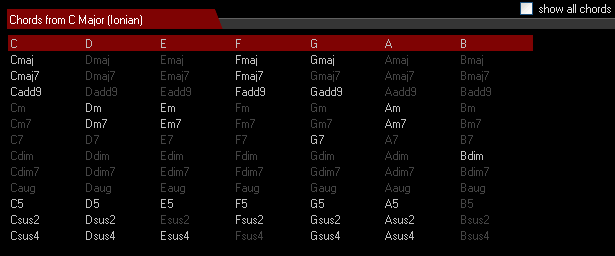Relationship between a scale and chords that can be formed out of its notes
This tab shows all chords that can be derived from a scale. Table lists all chords and highlighted ones are those that can be constructed using notes from that particular scale. This feature is really great in exploring scale-chord-arpeggio relationships.
Usage:
Click on a highlighted chord name in table and its arpeggio will be drawn in red dots over the scale.
Clicking on any chord name (highlighted or not), and then clicking play button you will hear scale playing over that chord as background. With this feature it is possible to hear any scale over any chord.
Next image clearly shows how a C Major scale can be easily harmonized using chords constructed on its degrees:
It is obvious from the table above that on 1st degree of C major scale Cmaj chord is formed.
On 2nd degree there is a D minor chord.
3rd degree – Em
4th degree-Fmaj
5th degree-Gmaj or more important(from music theory point of view) dominant chord,G7
6th-Am (natural minor)
7th-Bdim
show all chords if not checked table above shows only most common chord types and you can see at first sight main chords (major,minor,dominant and diminished) which can be obtained from a scale.If you check this option all chords supported in this application will be shown.
Tip:
|
After selecting any chord from table click red Play button and that chord will be continuously played with synth sound.The same can be done by double clicking any chord in table.(I bet that you’ve always wanted someone who will hold Am or Cmaj forever while you are soloing over them )
|
Tip:
|
Have you ever been confused with real meanings of music scales Modal theory?Theory states that from each scale can be derived few more scales with same notes.More precise if a scale contains 7 notes then there is 7 different scales called Modes which shares same notes as main scale.So from C major scale (containing C,D,E,F,G,A,B notes) we can obtain following seven modes:
C Major (Ionian) C,D,E,F,G,A,B
D Dorian D,E,F,G,A,B,C
E Phrygian E,F,G,A,B,C,D
F Lydian F,G,A,B,C,D,E
G Mixolydian G,A,B,C,D,E,F
A Aeolian (Natural minor) A,B,C,D,E,F,G
B Locrian B,C,D,E,F,G,A
As you can see all modes are the same,only difference is in starting note.Why then we think about them as different scales?Yes it is confusing,but if you hear it in harmony context you will hear clearly difference in sound and mood they produces.Here is where you can really benefit from “Scale to chords” page.
If you load C major scale and click on highlighted Dm chord starting play-you will hear notes from C major scale played over Dm chord.But! Notes will start playing from D instead of C and backing harmony will be Dm and what you will hear will be D dorian mode indeed!
If you click on Em and start playing,scale will be played from E and backing chord will be Em,and what are you hearing is E Phrygian!
Major scale and a few other scales are well known in music theory and for that reason its modes have names.But other modes from other scales are usually named as Mode I ,Mode II, Mode III …where I,II,III …means that mode starts from 1st,2nd,3rd…degree of original scale
|

